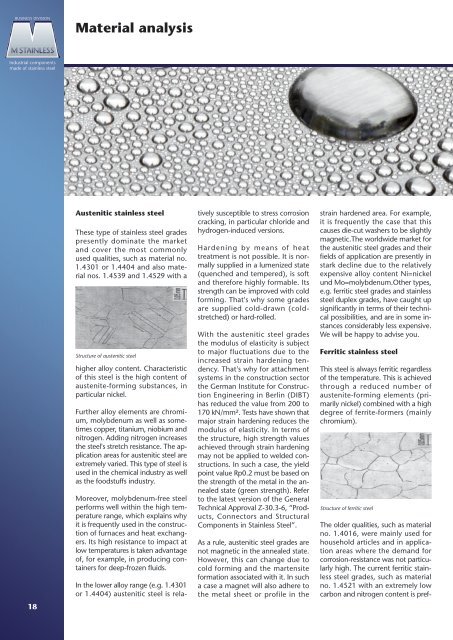The Stainless Steel Experts - MSTAINLESS
The Stainless Steel Experts - MSTAINLESS
The Stainless Steel Experts - MSTAINLESS
You also want an ePaper? Increase the reach of your titles
YUMPU automatically turns print PDFs into web optimized ePapers that Google loves.
BUSINESS DIVISION<br />
Industrial components<br />
made of stainless steel<br />
18<br />
Material analysis<br />
Austenitic stainless steel<br />
<strong>The</strong>se type of stainless steel grades<br />
presently dominate the market<br />
and cover the most commonly<br />
used qualities, such as material no.<br />
1.4301 or 1.4404 and also material<br />
nos. 1.4539 and 1.4529 with a<br />
Structure of austenitic steel<br />
higher alloy content. Characteristic<br />
of this steel is the high content of<br />
austenite-forming substances, in<br />
particular nickel.<br />
Further alloy elements are chromium,<br />
molybdenum as well as sometimes<br />
copper, titanium, niobium and<br />
nitrogen. Adding nitrogen increases<br />
the steel's stretch resistance. <strong>The</strong> application<br />
areas for austenitic steel are<br />
extremely varied. This type of steel is<br />
used in the chemical industry as well<br />
as the foodstuffs industry.<br />
Moreover, molybdenum-free steel<br />
performs well within the high temperature<br />
range, which explains why<br />
it is frequently used in the construction<br />
of furnaces and heat exchangers.<br />
Its high resistance to impact at<br />
low temperatures is taken advantage<br />
of, for example, in producing containers<br />
for deep-frozen fluids.<br />
In the lower alloy range (e.g. 1.4301<br />
or 1.4404) austenitic steel is rela-<br />
tively susceptible to stress corrosion<br />
cracking, in particular chloride and<br />
hydrogen-induced versions.<br />
Hardening by means of heat<br />
treatment is not possible. It is normally<br />
supplied in a lumenized state<br />
(quenched and tempered), is soft<br />
and therefore highly formable. Its<br />
strength can be improved with cold<br />
forming. That's why some grades<br />
are supplied cold-drawn (coldstretched)<br />
or hard-rolled.<br />
With the austenitic steel grades<br />
the modulus of elasticity is subject<br />
to major fluctuations due to the<br />
increased strain hardening tendency.<br />
That's why for attachment<br />
systems in the construction sector<br />
the German Institute for Construction<br />
Engineering in Berlin (DIBT)<br />
has reduced the value from 200 to<br />
170 kN/mm². Tests have shown that<br />
major strain hardening reduces the<br />
modulus of elasticity. In terms of<br />
the structure, high strength values<br />
achieved through strain hardening<br />
may not be applied to welded constructions.<br />
In such a case, the yield<br />
point value Rp0.2 must be based on<br />
the strength of the metal in the annealed<br />
state (green strength). Refer<br />
to the latest version of the General<br />
Technical Approval Z-30.3-6, “Products,<br />
Connectors and Structural<br />
Components in <strong>Stainless</strong> <strong>Steel</strong>”.<br />
As a rule, austenitic steel grades are<br />
not magnetic in the annealed state.<br />
However, this can change due to<br />
cold forming and the martensite<br />
formation associated with it. In such<br />
a case a magnet will also adhere to<br />
the metal sheet or profile in the<br />
strain hardened area. For example,<br />
it is frequently the case that this<br />
causes die-cut washers to be slightly<br />
magnetic.<strong>The</strong> worldwide market for<br />
the austenitic steel grades and their<br />
fields of application are presently in<br />
stark decline due to the relatively<br />
expensive alloy content Ni=nickel<br />
und Mo=molybdenum.Other types,<br />
e.g. ferritic steel grades and stainless<br />
steel duplex grades, have caught up<br />
significantly in terms of their technical<br />
possibilities, and are in some instances<br />
considerably less expensive.<br />
We will be happy to advise you.<br />
Ferritic stainless steel<br />
This steel is always ferritic regardless<br />
of the temperature. This is achieved<br />
through a reduced number of<br />
austenite-forming elements (primarily<br />
nickel) combined with a high<br />
degree of ferrite-formers (mainly<br />
chromium).<br />
Structure of ferritic steel<br />
<strong>The</strong> older qualities, such as material<br />
no. 1.4016, were mainly used for<br />
household articles and in application<br />
areas where the demand for<br />
corrosion-resistance was not particularly<br />
high. <strong>The</strong> current ferritic stainless<br />
steel grades, such as material<br />
no. 1.4521 with an extremely low<br />
carbon and nitrogen content is pref-


